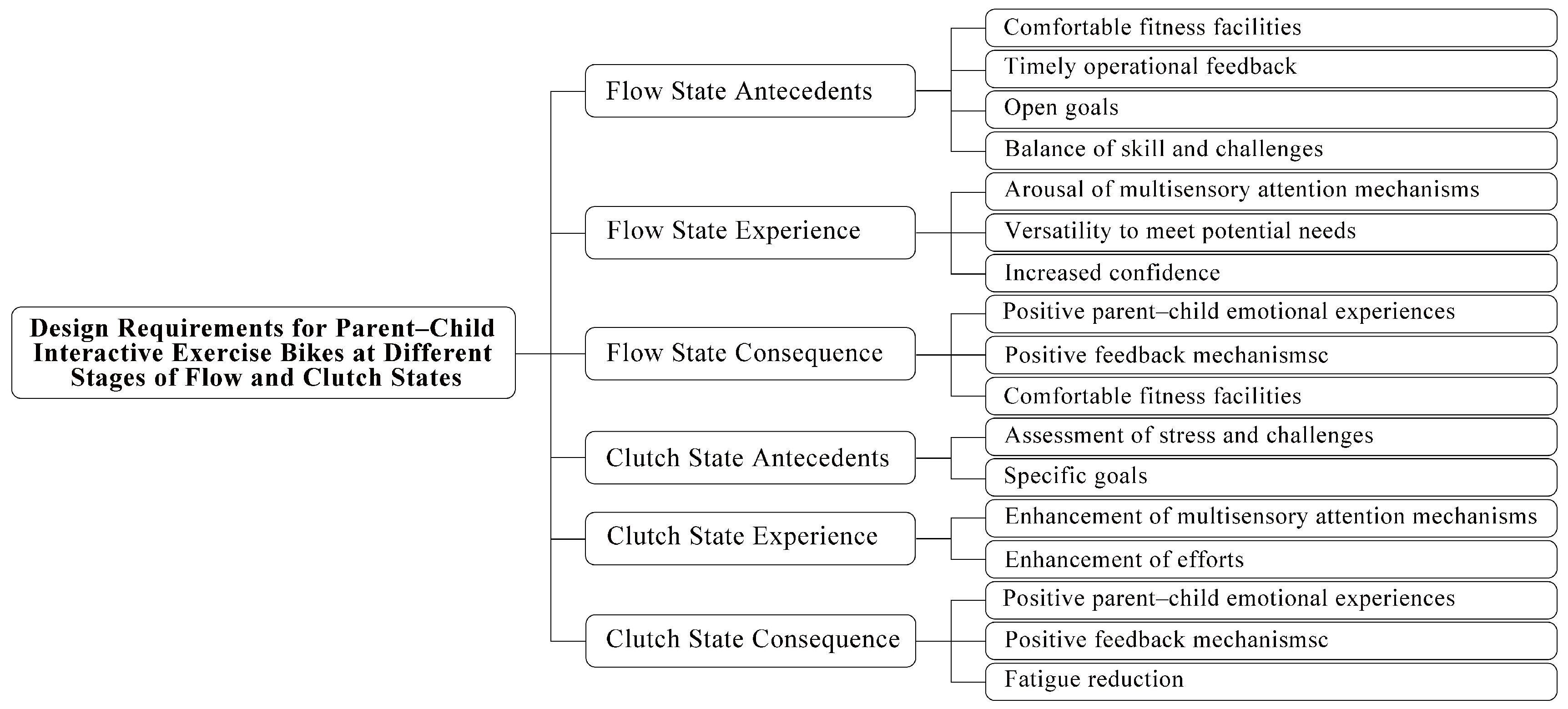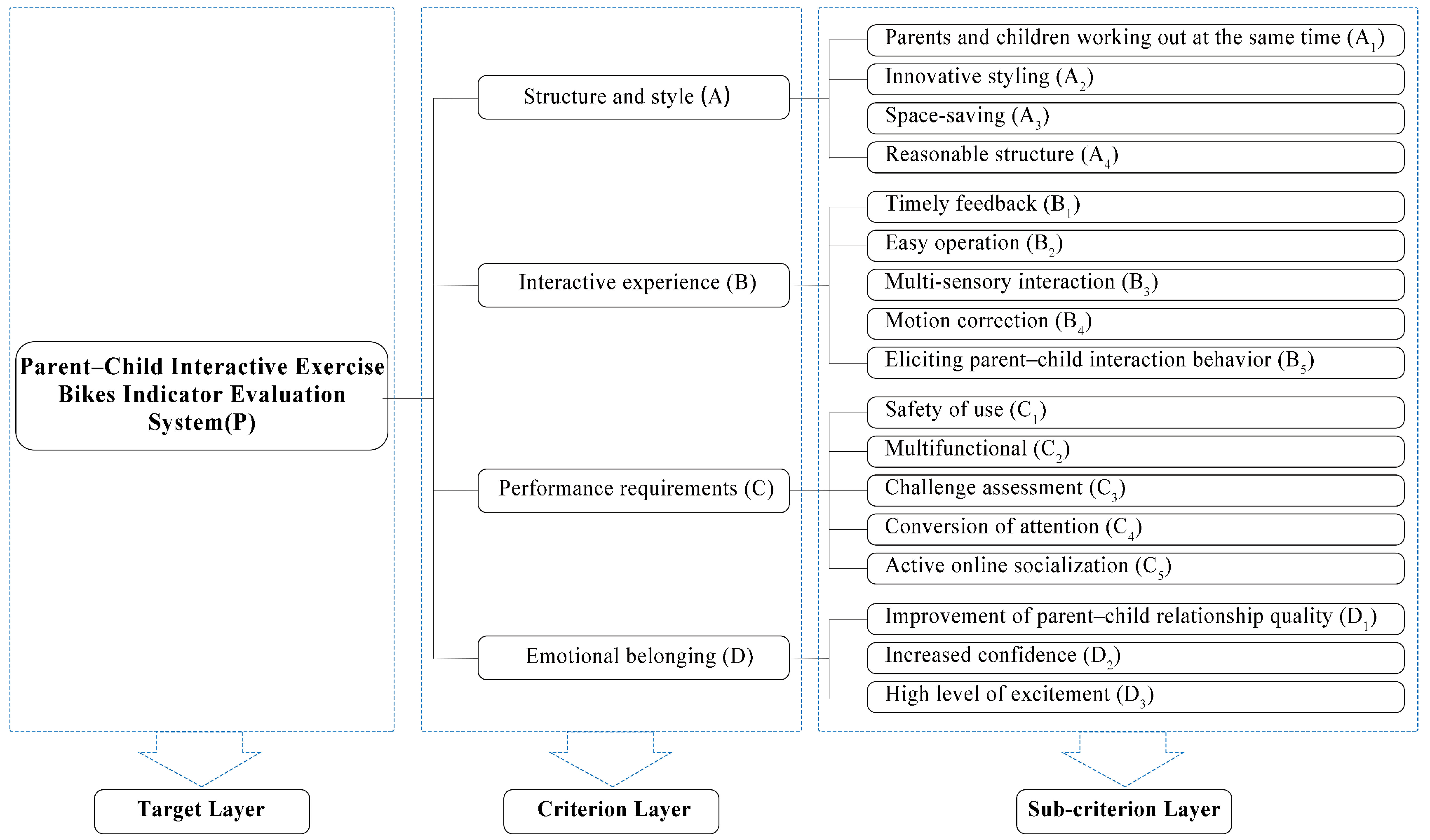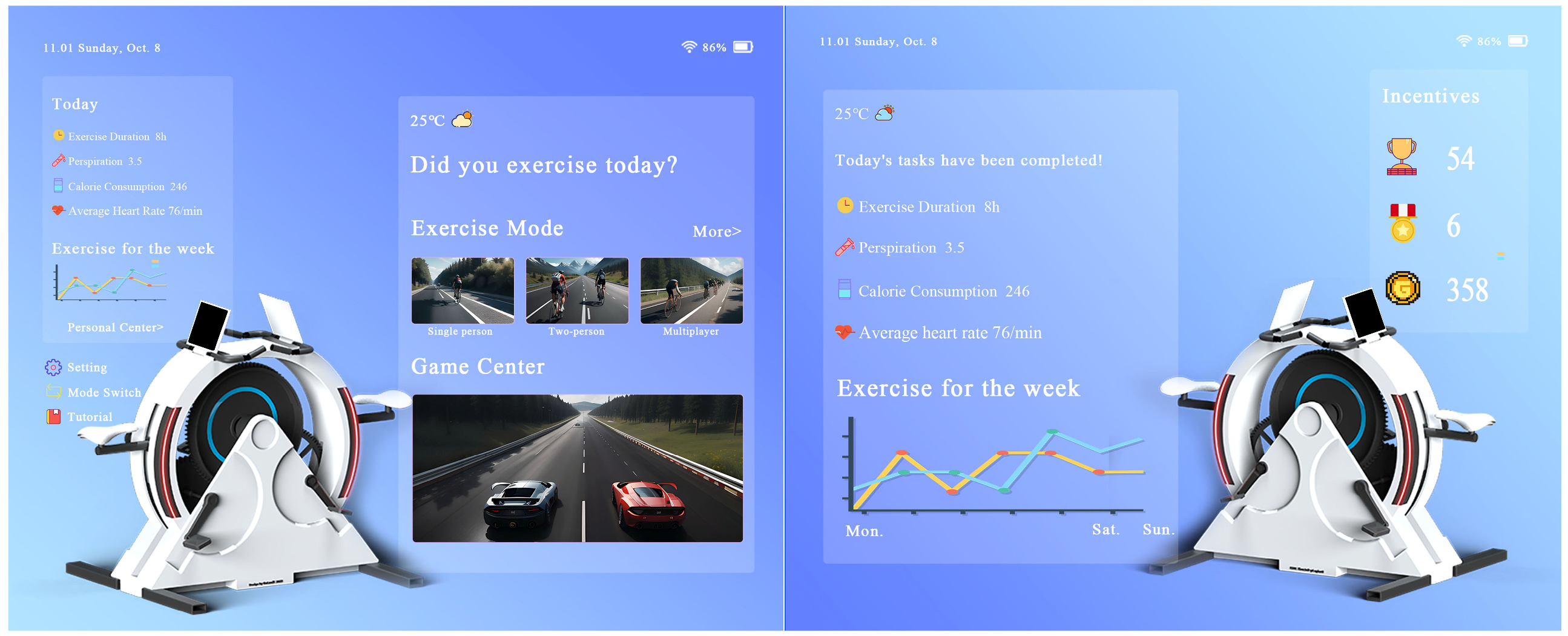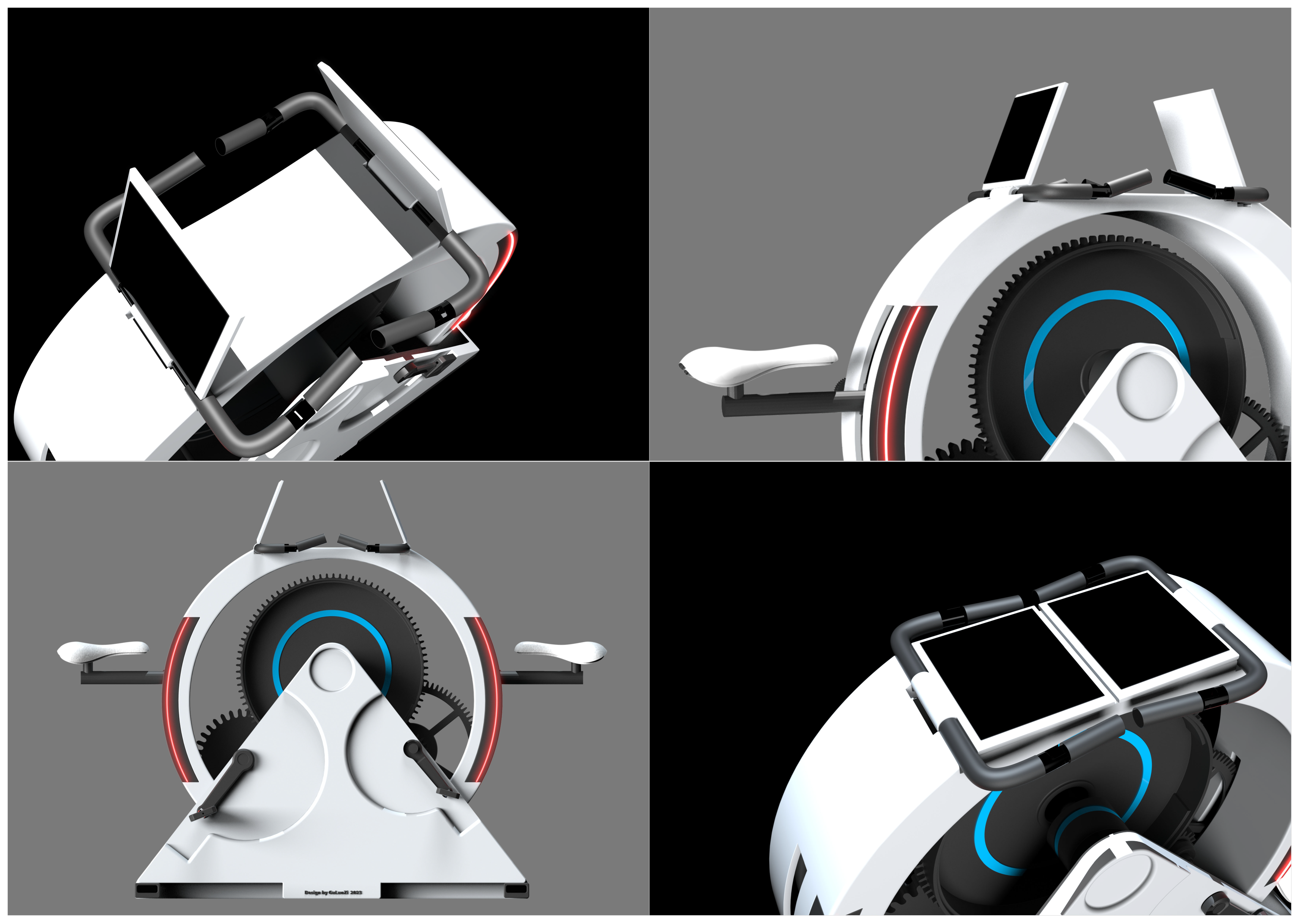The Application of Flow–Clutch States and AHP-QFD-FBS in the Design of Parent–Child Interaction Exercise Bikes
Abstract
1. Introduction
1.1. Background
1.2. Literature Review
1.3. Objectives
1.4. Significance
2. Methods
2.1. Analytic Hierarchy Process (AHP)
2.2. Quality Function Deployment (QFD)
2.3. Function–Behavior–Structure (FBS) Model
2.4. Fuzzy Comprehensive Evaluation (FCE)
3. Product Design Process Framework Based on Flow–Clutch States and AHP-QFD-FBS
3.1. User Requirements Analysis Based on Flow and Clutch States
3.2. Prioritizing and Quantifying Need Indicators
3.2.1. Construction and Calculation of Judgment Matrices
3.2.2. Consistency Test
3.2.3. Calculate the Comprehensive Weights of the Demand Indicators
3.2.4. Translation of User Requirements into Technical Characteristics
3.3. Derive Structure from Function
3.4. Design Program Evaluation
4. Results: Example Design of Parent–Child Interactive Exercise Bike
4.1. User Requirements Guided by Flow and Clutch States
4.2. Analysis of Parent–Child Interactive Exercise Bike User Requirements Using AHP
4.2.1. Identification of Indicators
4.2.2. Constructing Judgment Matrices
4.2.3. Consistency Test
4.2.4. Results of User Requirements Analysis
4.3. Identifying the Functional System of Parent–Child Interactive Exercise Bike
4.3.1. User Requirements Transformed into Technical Characteristics Based on QFD
4.3.2. HOQ Construction Process
4.4. Identifying the Functional Structure of Parent–Child Interactive Exercise Bike
4.4.1. Function–Behavior Mapping
4.4.2. Behavior–Structure Mapping
4.5. Scheme Design of Parent–Child Interactive Exercise Bike
4.6. Scheme Evaluation
- (1)
- Use the criteria layer indicators from the hierarchical model in Figure 3 as the assessment factor set , where , and the sub-criteria layer indicators as the second-level factor set .
- (2)
- Use the Likert five-point scale as the assessment grade standard, and set the evaluation set R = (R1, R2, R3, R4, R5) = (Very Satisfied, Satisfied, Average, Dissatisfied, Very Dissatisfied). Give distinct assessment scores to relevant assessment levels after value assignment: .
- (3)
- Assessment professionals were asked to evaluate the performance of every scheme indicator and acquired the fuzzy comprehensive assessment matrix for each indication:
4.7. User Satisfaction Survey
- (1)
- Parents were asked to evaluate the performance of every scheme indicator and acquired the fuzzy comprehensive assessment matrix for each indication:
- (2)
- The matrices , , , and are obtained by normalizing the matrices, respectively, and then utilizing the weighted average fuzzy operator via the synthesis operation of the index weights in Table 4, Table 5, Table 6 and Table 7 and the corresponding evaluation matrix , the evaluation weight vector of the criterion layer index of the design scheme can be determined. Finally, it is thus possible to create a fuzzy comprehensive evaluation matrix of target layer indicators:
- (3)
- Likewise, it is possible to compute the comprehensive evaluation vector for the parent–child interactive exercise bike design scheme:
- (4)
- Ultimately, the total assessment score for the scheme is calculated:
5. Discussion
6. Conclusions
Supplementary Materials
Author Contributions
Funding
Institutional Review Board Statement
Informed Consent Statement
Data Availability Statement
Acknowledgments
Conflicts of Interest
Appendix A
| Module | Content |
|---|---|
| User Background Information | 1. What is your family structure? (e.g., children’s ages, number of children, etc.) |
| 2. What are your and your child’s exercise habits? Do you have a fixed workout schedule? | |
| 3. Have you used similar fitness equipment before? If yes, please describe your experience. | |
| Overall Satisfaction | 1. How satisfied are you with the overall design of the parent–child interactive exercise bike? |
| 2. What part of the design appeals to you the most? | |
| 3. What aspects of the design need improvement? | |
| Flow Experience | 1. Ease of Operation: Are you satisfied with the device’s operation process design? (e.g., startup, settings, mode switching) |
| 2. Real-Time Feedback: Are you satisfied with the real-time feedback design (e.g., speed, distance, calories burned)? | |
| 3. Interface Design: Are you satisfied with the device’s interface design? (e.g., simplicity, suitability for children) | |
| 4. Task Coherence: Are you satisfied with the design guidance for transitions between tasks (e.g., smooth switching, seamless connections)? | |
| Clutch Experience | 1. Task Completion and Reward Mechanism: Are you satisfied with the feedback design after task completion (e.g., celebration animations, sound effects, rewards)? |
| 2. Emotional Design: During the final stretch or when encountering difficulties, are you satisfied with the device’s interaction and emotional connection design? | |
| Parent–Child Interaction | 1. Interaction Formats: Are you satisfied with the interaction formats provided by the design (e.g., competitions, cooperative tasks, virtual adventures)? |
| 2. Fun and Engagement: Do you think the device’s fun design (e.g., gamified tasks, virtual scenarios) can attract you and your child? | |
| 3. Parent–Child Emotional Experience: Do you think this design can effectively enhance parent–child relationships or foster a sense of competition and cooperation? | |
| Safety and Space Optimization | 1. Safety: Are you satisfied with the device’s safety design (e.g., antislip, speed limits, emergency braking)? |
| 2. Space Optimization: Are you satisfied with the device’s size and storage features (e.g., foldable design, lightweight and portable)? | |
| Other Suggestions | 1. What suggestions do you have for improving the overall design? |
| 2. What additional features or characteristics do you think the device should have? |
| Module | Content |
|---|---|
| Overall Satisfaction | 1. Do you like using this exercise bike with your parents? Why or why not? |
| Flow Experience | 1. Ease of Operation: Are you satisfied with the device’s operation process design? (e.g., startup, settings, mode switching) |
| Clutch Experience | 1. Task Completion and Reward Mechanism: Are you satisfied with the feedback design after task completion (e.g., celebration animations, sound effects, rewards)? |
| Interestingness | 1. Which features of the design do you find the most attractive? (e.g., races, adventure tasks) |
| 2. Do you think the interface design of the exercise bike and the app is nice? What parts do you like? | |
| Interaction Experience | 1. What tasks do you enjoy completing with your parents? (e.g., competitions, cooperative tasks) |
| 2. Do you think this design makes playing together more fun? Why or why not? | |
| Safety and Comfort | 1. Are you satisfied with the safety design of the device? (e.g., anti-slip, speed limits, emergency braking) |
| 2. Do you like the appearance design of the exercise bike? Do you think it looks cool? | |
| Other Suggestions | 1. What else would you like the exercise bike to do? (e.g., tell stories, play music) |
References
- Bi, J.-L.; Chen, J.; Sun, X.-M.; Nie, X.-L.; Liu, Y.-Y. The development and evaluation of a sub-health self-rating scale for university students in China. BMC Public Health 2019, 19, 330. [Google Scholar] [CrossRef] [PubMed]
- Liang, Y.Z.; Chu, X.; Meng, S.J.; Zhang, J.; Wu, L.J.; Yan, Y.X. Relationship between stress-related psychosocial work factors and suboptimal health among Chinese medical staff: A cross-sectional study. BMJ Open 2018, 8, e018485. [Google Scholar] [CrossRef] [PubMed]
- Subspecialty Group of Respiratory Diseases, the Society of Pediatrics, Chinese Medical Association; Child Health Special Committee, Chongqing Maternal and Child Health Association; Vaccine and Health Branch of China Health Culture Association. Expert Recommendations for the Prevention and Control of COVID-19 Infections in Primary Care (First Edition). Chin. J. Gen. Pract. 2020, 19, E010. [Google Scholar]
- Chen, J.; Cheng, J.; Liu, Y.; Tang, Y.; Sun, X.; Wang, T.; Xiao, Y.; Li, F.; Xiang, L.; Jiang, P. Associations between breakfast eating habits and health-promoting lifestyle, suboptimal health status in Southern China: A population based, cross sectional study. J. Transl. Med. 2014, 12, 348. [Google Scholar] [CrossRef]
- Crouter, A.C.; Bumpus, M.F.; Maguire, M.C.; McHale, S.M. Linking parents’ work pressure and adolescents’ well being: Insights into dynamics in dual earner families. Dev. Psychol. 1999, 35, 1453. [Google Scholar] [CrossRef]
- Roeters, A.; Van Der Lippe, T.; Kluwer, E.S. Work characteristics and parent-child relationship quality: The mediating role of temporal involvement. J. Marriage Fam. 2010, 72, 1317–1328. [Google Scholar] [CrossRef]
- Verweij, R.; Helmerhorst, K.; Keizer, R. Work-to-family conflict, family-to-work conflict and their relation to perceived parenting and the parent-child relationship before and during the first COVID-19 lockdown. J. Fam. Res. 2021, 33, 734–771. [Google Scholar] [CrossRef]
- Haapala, E. Physical Activity, Sedentary Behavior, Physical Performance, Adiposity, and Academic Achievement in Primary-School Children. Ph.D. Thesis, Itä-Suomen Yliopisto, Joensuu, Finland, 2015. [Google Scholar]
- Zhu, X.; Haegele, J.A.; Tang, Y.; Wu, X. Physical activity and sedentary behaviors of urban Chinese children: Grade level prevalence and academic burden associations. BioMed Res. Int. 2017, 2017, 7540147. [Google Scholar] [CrossRef]
- de Moraes, A.C.F.; Carvalho, H.B.; Siani, A.; Barba, G.; Veidebaum, T.; Tornaritis, M.; Molnar, D.; Ahrens, W.; Wirsik, N.; De Henauw, S. Incidence of high blood pressure in children—Effects of physical activity and sedentary behaviors: The IDEFICS study: High blood pressure, lifestyle and children. Int. J. Cardiol. 2015, 180, 165–170. [Google Scholar] [CrossRef]
- Tremblay, M.S.; LeBlanc, A.G.; Kho, M.E.; Saunders, T.J.; Larouche, R.; Colley, R.C.; Goldfield, G.; Gorber, S.C. Systematic review of sedentary behaviour and health indicators in school-aged children and youth. Int. J. Behav. Nutr. Phys. Act. 2011, 8, 98. [Google Scholar] [CrossRef]
- Kim, E.; Lee, M. The reciprocal longitudinal relationship between the parent-adolescent relationship and academic stress in Korea. Soc. Behav. Personal. 2013, 41, 1519–1532. [Google Scholar] [CrossRef]
- Ding, Y.; Liu, J. Physical exercise under positive psychology improves the psychological sub-health state of international trade workers. Rev. Psicol. Del. Deporte (J. Sport Psychol.) 2023, 32, 347–356. [Google Scholar]
- Teng, H.; Bao, Z.; Yang, F. Influencing Factors and Improving Measures of Sub-health of Universities Teachers. In Proceedings of the 2020 Conference on Social Science and Modern Science (SSMS2020), Dalian, China, 13–14 March 2020. [Google Scholar]
- Zeng, Z.-P.; Wu, H.-P.; Bi, C.-J.; Zheng, D.-H.; Chen, Q.; Yin, X.-J.; Cao, J.-F. Correlation between physical exercise, screen time and mental sub-health among Chinese adolescents. Chin. J. Sch. Health 2021, 42, 23–27. [Google Scholar]
- Guirado, T.; Chambonnière, C.; Chaput, J.-P.; Metz, L.; Thivel, D.; Duclos, M. Effects of classroom active desks on children and adolescents’ physical activity, sedentary behavior, academic achievements and overall health: A systematic review. Int. J. Environ. Res. Public Health 2021, 18, 2828. [Google Scholar] [CrossRef] [PubMed]
- Miao, Y.; Gao, X.; Jiang, W.; Xu, W. An evaluation model for interactive gaming furniture design based on parent-child behavior. PLoS ONE 2024, 19, e0302713. [Google Scholar] [CrossRef]
- Yao, X.; Poonyaprapha, P. A study of the parent-child experience designfor public space of community shopping center: A case study of tianjin future world shopping center. J. Roi Kaensarn Acad. 2023, 8, 152–167. [Google Scholar]
- Zhou, B. Analysis of Design Factors for Parent-child Toys: An Exploration from the Perspectives of Children’s Psychology and Parental Needs. Appl. Educ. Psychol. 2024, 5, 151–156. [Google Scholar]
- Csikszentmihalyi, M. Beyond Boredom and Anxiety; Jossey-Bass: San Francisco, CA, USA, 2000. [Google Scholar]
- Schweickle, M.J.; Vella, S.A.; Swann, C. Exploring the “clutch” in clutch performance: A qualitative investigation of the experience of pressure in successful performance. Psychol. Sport Exerc. 2021, 54, 101889. [Google Scholar] [CrossRef]
- Swann, C.; Crust, L.; Vella, S.A. New directions in the psychology of optimal performance in sport: Flow and clutch states. Curr. Opin. Psychol. 2017, 16, 48–53. [Google Scholar] [CrossRef]
- Jackman, P.; Crust, L.; Swann, C. The role of mental toughness in the occurrence of flow and clutch states in sport. Int. J. Sport Psychol. 2020, 51, 1–27. [Google Scholar]
- Yi, Q.; Liu, Z.; Liu, X.; Wang, Y.; Li, R. The development strategies of amateur table tennis matches in China based on the SWOT-AHP model: A case study in Shanghai. Sci. Rep. 2024, 14, 12060. [Google Scholar] [CrossRef] [PubMed]
- de FSM Russo, R.; Camanho, R. Criteria in AHP: A systematic review of literature. Procedia Comput. Sci. 2015, 55, 1123–1132. [Google Scholar] [CrossRef]
- Pérez, J. Some comments on Saaty’s AHP. Manag. Sci. 1995, 41, 1091–1095. [Google Scholar] [CrossRef]
- Ariff, H.; Salit, M.S.; Ismail, N.; Nukman, Y. Use of analytical hierarchy process (AHP) for selecting the best design concept. J. Teknol. 2008, 49, 1–18. [Google Scholar] [CrossRef]
- Saaty, T.L. An exposition of the AHP in reply to the paper “remarks on the analytic hierarchy process”. Manag. Sci. 1990, 36, 259–268. [Google Scholar] [CrossRef]
- Yue, H.; Zhu, T.-L.; Zhou, Z.-J.; Zhou, T. Improvement of evaluation method of elderly family medical product design based on AHP. Math. Probl. Eng. 2022, 2022, 4036030. [Google Scholar] [CrossRef]
- Zhu, T.-L.; Li, Y.-J.; Wu, C.-J.; Yue, H.; Zhao, Y.-Q. Research on the design of surgical auxiliary equipment based on AHP, QFD, and PUGH decision matrix. Math. Probl. Eng. 2022, 2022, 4327390. [Google Scholar] [CrossRef]
- Tu, N.; Zhang, T.; He, Q.; Zhang, H.; Li, Y. Applying combined AHP-QFD method in new product development: A case study in developing new sports earphone. In Proceedings of the MSIE 2011, Harbin, China, 8–11 January 2011; IEEE: New York, NY, USA, 2011; pp. 80–85. [Google Scholar]
- Zhao, Y.; Wang, T.; Zhang, C.; Hamat, B.; Pang, L.L.L. Research on the application of AHP-FAST-FBS in the design of home entrance disinfection devices in the post-pandemic era. Sci. Rep. 2024, 14, 20550. [Google Scholar]
- Singh, B. Analytical hierarchical process (AHP) and fuzzy AHP applications—A review paper. Int. J. Pharm. Technol. 2016, 8, 4925–4946. [Google Scholar]
- Lin, M.-C.; Wang, C.-C.; Chen, M.-S.; Chang, C.A. Using AHP and TOPSIS approaches in customer-driven product design process. Comput. Ind. 2008, 59, 17–31. [Google Scholar] [CrossRef]
- Ma, G.; Guo, Y. Quantitative Evaluation System of Indoor Fitness Equipment for the Elderly Based on AHP-TOPSIS. In Proceedings of the 2023 4th International Conference on Education, Knowledge and Information Management (ICEKIM 2023), Zhengzhou, China, 13–15 January 2023; Atlantis Press: Paris, France, 2023; pp. 510–520. [Google Scholar]
- Ercan, C. Multi-Criteria Evaluation of Mobile Fitness Applications During COVID-19 Pandemic Based on AHP. Pamukkale J. Sport Sci. 2023, 14, 43–62. [Google Scholar] [CrossRef]
- Govers, C.P. What and how about quality function deployment (QFD). Int. J. Prod. Econ. 1996, 46, 575–585. [Google Scholar] [CrossRef]
- Iovan-Dragomir, A.; Luca, A. Application of QFD Method in Fitness Footwear Production. Leather Footwear J./Rev. Piel. Incaltaminte 2018, 18, 153–162. [Google Scholar] [CrossRef]
- Carnevalli, J.A.; Miguel, P.C. Review, analysis and classification of the literature on QFD—Types of research, difficulties and benefits. Int. J. Prod. Econ. 2008, 114, 737–754. [Google Scholar] [CrossRef]
- Sousa-Zomer, T.T.; Miguel, P.A.C. A QFD-based approach to support sustainable product-service systems conceptual design. Int. J. Adv. Manuf. Technol. 2017, 88, 701–717. [Google Scholar] [CrossRef]
- Cascini, G.; Fantoni, G.; Montagna, F. Situating needs and requirements in the FBS framework. Des. Stud. 2013, 34, 636–662. [Google Scholar] [CrossRef]
- Duanshu, S.; Xiaoting, L.U.; Yanqiu, X.U.; Tianqi, C. Study on the Design of Elderly Rehabilitation Apparatus Based on FBS Model. Furniture 2017, 5, 77–82. [Google Scholar]
- Hridoy, R.M.; Parvez, M.S.; Mohsin, N. Joining methods of Analytic Hierarchy Process (AHP), Kano Model and Quality Function Deployment (QFD) to improve the tractor’s seat design for tractor drivers in Bangladesh. Am. J. Ind. Bus. Manag. 2020, 10, 1073. [Google Scholar] [CrossRef]
- Ahmad, M.N.; Maidin, N.; Rahman, M.; Osman, M. Conceptual design selection of manual wheelchair for elderly by analytical hierarchy process (AHP) method: A case study. Int. J. Appl. Eng. Res. 2017, 12, 6710–6719. [Google Scholar]
- Guo, Y.; Xu, J. Application of Quality Function Deployment and Function-Behavior-Structure Model in the Innovative Design of Hospital Guide Robot. In Proceedings of the 2024 International Conference on Culture-Oriented Science & Technology (CoST), Beijing, China, 25–28 August 2024; IEEE: New York, NY, USA, 2024; pp. 236–241. [Google Scholar]
- Jackman, P.C.; Hawkins, R.M.; Whitehead, A.E.; Brick, N.E. Integrating models of self-regulation and optimal experiences: A qualitative study into flow and clutch states in recreational distance running. Psychol. Sport Exerc. 2021, 57, 102051. [Google Scholar] [CrossRef]
- Boudreau, P.; Mackenzie, S.H.; Hodge, K. Optimal psychological states in advanced climbers: Antecedents, characteristics, and consequences of flow and clutch states. Psychol. Sport Exerc. 2022, 60, 102155. [Google Scholar] [CrossRef]
- Swann, C.; Crust, L.; Jackman, P.; Vella, S.A.; Allen, M.S.; Keegan, R. Psychological States Underlying Excellent Performance in Sport: Toward an Integrated Model of Flow and Clutch States. J. Appl. Sport Psychol. 2017, 29, 375–401. [Google Scholar] [CrossRef]
- Han, S.B.; Chen, S.K.; Ebrahimpour, M.; Sodhi, M.S. A conceptual QFD planning model. Int. J. Qual. Reliab. Manag. 2001, 18, 796–812. [Google Scholar] [CrossRef]
- Akao, Y.; Mazur, G.H. The leading edge in QFD: Past, present and future. Int. J. Qual. Reliab. Manag. 2003, 20, 20–35. [Google Scholar] [CrossRef]
- Gero, J.S. Design prototypes: A knowledge representation schema for design. AI Mag. 1990, 11, 26. [Google Scholar]
- Galle, P. The ontology of Gero’s FBS model of designing. Des. Stud. 2009, 30, 321–339. [Google Scholar] [CrossRef]
- Feng, S.; Xu, L.D. Decision support for fuzzy comprehensive evaluation of urban development. Fuzzy Sets Syst. 1999, 105, 1–12. [Google Scholar] [CrossRef]
- Zhou, R.; Chan, A.H. Using a fuzzy comprehensive evaluation method to determine product usability: A proposed theoretical framework. Work 2017, 56, 9–19. [Google Scholar] [CrossRef]
- Zhu, L. Research and application of AHP-fuzzy comprehensive evaluation model. Evol. Intell. 2022, 15, 2403–2409. [Google Scholar] [CrossRef]
- Nakamura, J.; Csikszentmihalyi, M. The concept of flow. Handb. Posit. Psychol. 2002, 89, 105. [Google Scholar]
- Swann, C.; Crust, L.; Jackman, P.; Vella, S.A.; Allen, M.S.; Keegan, R. Performing under pressure: Exploring the psychological state underlying clutch performance in sport. J. Sports Sci. 2017, 35, 2272–2280. [Google Scholar] [CrossRef] [PubMed]












| n | 3 | 4 | 5 | 6 | 7 | 8 | 9 | 10 |
|---|---|---|---|---|---|---|---|---|
| 0.52 | 0.89 | 1.12 | 1.26 | 1.36 | 1.41 | 1.46 | 1.49 |
| Scale Value | Importance Level | Implication |
|---|---|---|
| 1 | Equally important | Indicator I is of equal importance compared to Indicator J |
| 3 | Slightly important | Indicator I is slightly more important compared to Indicator J |
| 5 | Obviously important | Indicator I is obviously important compared to Indicator J |
| 7 | Significantly important | Indicator I is significantly important compared to Indicator J |
| 9 | Absolutely important | Indicator I is absolutely important compared to Indicator J |
| 2, 4, 6, 8 | Intermediate value | The importance level is between two adjacent levels |
| 1/2, 1/3, … 1/9 | Reverse comparison | If the importance scale of indicator A over indicator B is “n”, the reverse comparison is “1/n” |
| P | A | B | C | D | Weights |
|---|---|---|---|---|---|
| A | 1.0000 | 1.0890 | 1.7420 | 2.1820 | 0.3392 |
| B | 0.9184 | 1.0000 | 1.5710 | 2.0400 | 0.3115 |
| C | 0.5740 | 0.6366 | 1.0000 | 1.1300 | 0.1906 |
| D | 0.4582 | 0.4901 | 0.8849 | 1.0000 | 0.1588 |
| A | A1 | A2 | A3 | A4 | Weights |
|---|---|---|---|---|---|
| A1 | 1.0000 | 2.6680 | 1.6980 | 1.6160 | 0.3910 |
| A2 | 0.3748 | 1.0000 | 0.7340 | 0.9190 | 0.1685 |
| A3 | 0.5889 | 1.3624 | 1.0000 | 0.7940 | 0.2124 |
| A4 | 0.6190 | 1.0885 | 1.2597 | 1.0000 | 0.2282 |
| B | B1 | B2 | B3 | B4 | B5 | Weights |
|---|---|---|---|---|---|---|
| B1 | 1.0000 | 3.2380 | 3.0920 | 0.8360 | 1.7110 | 0.3099 |
| B2 | 0.3088 | 1.0000 | 1.2140 | 0.4260 | 0.9530 | 0.1249 |
| B3 | 0.3234 | 0.8236 | 1.0000 | 0.3260 | 0.5890 | 0.1004 |
| B4 | 1.1957 | 2.3486 | 3.0671 | 1.0000 | 1.0760 | 0.2840 |
| B5 | 0.5845 | 1.0488 | 1.6981 | 0.9296 | 1.0000 | 0.1808 |
| C | C1 | C2 | C3 | C4 | C5 | Weights |
|---|---|---|---|---|---|---|
| C1 | 1.0000 | 3.6320 | 1.4680 | 2.4810 | 1.5880 | 0.3299 |
| C2 | 0.2753 | 1.0000 | 0.4470 | 0.8490 | 0.3410 | 0.0921 |
| C3 | 0.6813 | 2.2361 | 1.0000 | 2.5880 | 1.1780 | 0.2440 |
| C4 | 0.4031 | 1.1774 | 0.3864 | 1.0000 | 0.5670 | 0.1141 |
| C5 | 0.6298 | 2.9356 | 0.8490 | 1.7627 | 1.0000 | 0.2200 |
| D | D1 | D2 | D3 | Weights |
|---|---|---|---|---|
| D1 | 1.000 | 1.497 | 1.000 | 0.374 |
| D2 | 0.668 | 1.000 | 0.648 | 0.248 |
| D3 | 1.000 | 1.543 | 1.000 | 0.378 |
| P | A | B | C | D | |
|---|---|---|---|---|---|
| 4.002 | 4.027 | 5.081 | 5.031 | 3.000 | |
| 0.001 | 0.009 | 0.020 | 0.008 | 0.000 | |
| 0.890 | 0.890 | 1.120 | 1.120 | 0.520 | |
| 0.001 | 0.010 | 0.018 | 0.007 | 0.000 |
| Criterion Layer | Weights | Sub-Criterion Layer | Weights | Comprehensive Weights | Ranking |
|---|---|---|---|---|---|
| A | 0.3392 | A1 | 0.3910 | 0.1326 | 1 |
| A2 | 0.1685 | 0.0572 | 9 | ||
| A3 | 0.2124 | 0.0720 | 5 | ||
| A4 | 0.2282 | 0.0774 | 4 | ||
| B | 0.3115 | B1 | 0.3099 | 0.0965 | 2 |
| B2 | 0.1249 | 0.0389 | 14 | ||
| B3 | 0.1004 | 0.0313 | 15 | ||
| B4 | 0.2840 | 0.0885 | 3 | ||
| B5 | 0.1808 | 0.0563 | 10 | ||
| C | 0.1906 | C1 | 0.3299 | 0.0629 | 6 |
| C2 | 0.0921 | 0.0176 | 17 | ||
| C3 | 0.2440 | 0.0465 | 11 | ||
| C4 | 0.1141 | 0.0218 | 16 | ||
| C5 | 0.2200 | 0.0419 | 12 | ||
| D | 0.1588 | D1 | 0.3743 | 0.0594 | 8 |
| D2 | 0.2475 | 0.0393 | 13 | ||
| D3 | 0.3781 | 0.0600 | 7 |
| Types of User Requirements | User Requirements | Technical Characteristics |
|---|---|---|
| A | A1 | Ergonomics |
| Double position structure | ||
| A2 | Appearance design | |
| A3 | Folding and moving structure | |
| A4 | Ergonomics | |
| B | B1 | Acquisition of motion data |
| B2 | Intelligent software control | |
| B3 | Audio–visual and speaking systems | |
| B4 | Acquisition of motion data | |
| Intelligent guidance interface | ||
| B5 | Parent–child interaction | |
| Intelligent software control | ||
| Virtual reality scenario | ||
| C | C1 | Ergonomics |
| C2 | Intelligent software control | |
| C3 | Acquisition of motion data | |
| C4 | Intelligent guidance interface | |
| C5 | Intelligent software control | |
| D | D1 | Parent–child interaction design |
| D2 | Intelligent guidance interface | |
| Acquisition of motion data | ||
| D3 | Intelligent guidance interface | |
| Acquisition of motion data |
| Serial Number | Technical Characteristics |
|---|---|
| T1 | Ergonomics |
| T2 | Appearance design |
| T3 | Folding and moving structure |
| T4 | Acquisition of motion data |
| T5 | Intelligent software control |
| T6 | Audio–visual and speaking systems |
| T7 | Parent–child interaction design |
| T8 | Intelligent guidance interface |
| T9 | Virtual reality scenario |
| User Requirement | Technical Characteristics | |||||||||
|---|---|---|---|---|---|---|---|---|---|---|
| Requirement | Weights | T1 | T2 | T3 | T4 | T5 | T6 | T7 | T8 | T9 |
| P11 | 0.1326 | ▣ | ◎ | ◎ | ◎ | ◯ | ▣ | ◎ | ||
| P12 | 0.0572 | ◯ | ▣ | ◎ | ◎ | ▣ | ||||
| P13 | 0.0720 | ◯ | ▣ | ▣ | ▣ | |||||
| P14 | 0.0774 | ◎ | ◎ | ▣ | ◎ | ◎ | ||||
| P21 | 0.0965 | ◎ | ▣ | ◯ | ◎ | |||||
| P22 | 0.0389 | ▣ | ▣ | ▣ | ▣ | ▣ | ◎ | ◎ | ◎ | |
| P23 | 0.0313 | ◯ | ◎ | ▣ | ◯ | ▣ | ▣ | |||
| P24 | 0.0885 | ◯ | ▣ | ◎ | ▣ | |||||
| P25 | 0.0563 | ◎ | ◎ | ◯ | ◎ | ▣ | ◎ | ◯ | ||
| P31 | 0.0629 | ▣ | ▣ | ▣ | ||||||
| P32 | 0.0176 | ▣ | ◯ | ◎ | ◎ | |||||
| P33 | 0.0465 | ▣ | ▣ | |||||||
| P34 | 0.0218 | ▣ | ◎ | |||||||
| P35 | 0.0419 | ◎ | ◯ | ◯ | ||||||
| P41 | 0.0594 | ◎ | ◎ | ◎ | ◯ | ▣ | ◎ | |||
| P42 | 0.0393 | ◯ | ◎ | ◎ | ◎ | |||||
| P43 | 0.0600 | ◯ | ◎ | ◎ | ◎ | |||||
| (×100) | 154 | 142 | 186 | 167 | 106 | 220 | 236 | 177 | 126 | |
| (%) | 10.14 | 9.37 | 12.27 | 11.03 | 7.03 | 14.55 | 15.61 | 11.69 | 8.30 | |
| Ranking | 6 | 7 | 3 | 5 | 9 | 2 | 1 | 4 | 8 | |
Disclaimer/Publisher’s Note: The statements, opinions and data contained in all publications are solely those of the individual author(s) and contributor(s) and not of MDPI and/or the editor(s). MDPI and/or the editor(s) disclaim responsibility for any injury to people or property resulting from any ideas, methods, instructions or products referred to in the content. |
© 2025 by the authors. Licensee MDPI, Basel, Switzerland. This article is an open access article distributed under the terms and conditions of the Creative Commons Attribution (CC BY) license (https://creativecommons.org/licenses/by/4.0/).
Share and Cite
Li, N.; Wang, J.; Wei, H. The Application of Flow–Clutch States and AHP-QFD-FBS in the Design of Parent–Child Interaction Exercise Bikes. Appl. Sci. 2025, 15, 3270. https://doi.org/10.3390/app15063270
Li N, Wang J, Wei H. The Application of Flow–Clutch States and AHP-QFD-FBS in the Design of Parent–Child Interaction Exercise Bikes. Applied Sciences. 2025; 15(6):3270. https://doi.org/10.3390/app15063270
Chicago/Turabian StyleLi, Na, Jun Wang, and Huilan Wei. 2025. "The Application of Flow–Clutch States and AHP-QFD-FBS in the Design of Parent–Child Interaction Exercise Bikes" Applied Sciences 15, no. 6: 3270. https://doi.org/10.3390/app15063270
APA StyleLi, N., Wang, J., & Wei, H. (2025). The Application of Flow–Clutch States and AHP-QFD-FBS in the Design of Parent–Child Interaction Exercise Bikes. Applied Sciences, 15(6), 3270. https://doi.org/10.3390/app15063270






